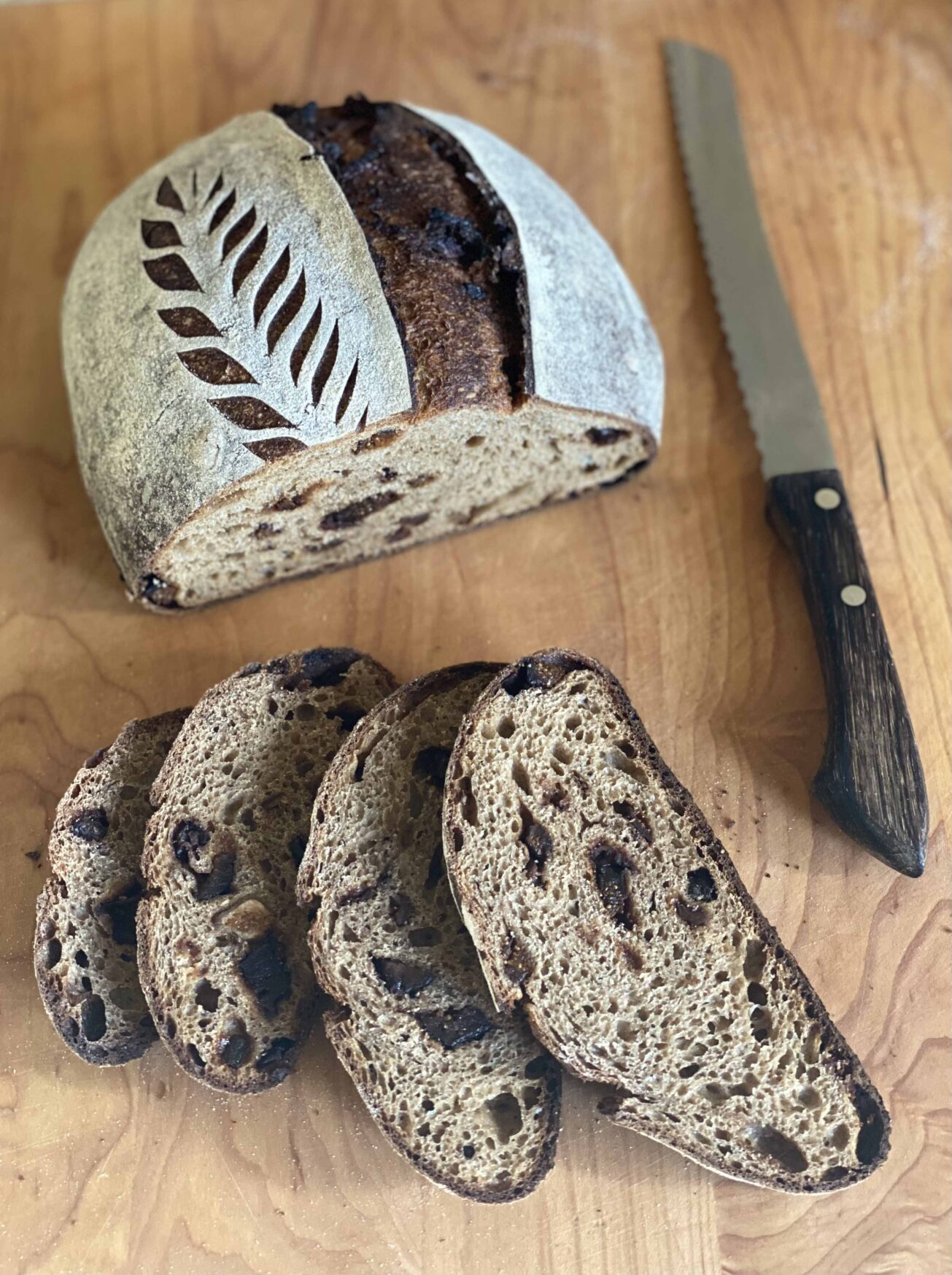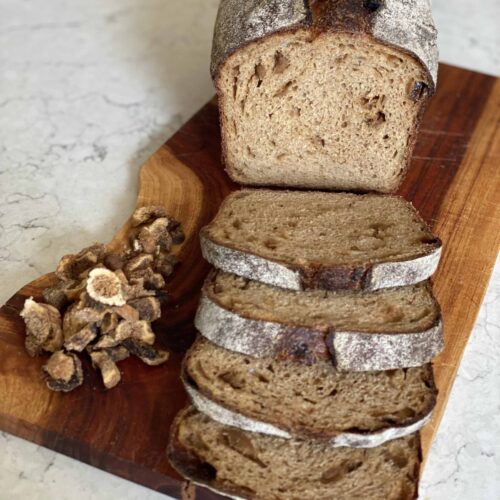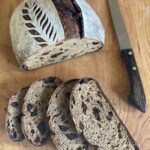The deep and rich flavor of dried mission figs is the perfect pairing for aromatic, earthy flours such as rye and buckwheat in sourdough whole grain bread. Knowing how to balance flours for flavor and structure in sourdough rye bread recipes is key.
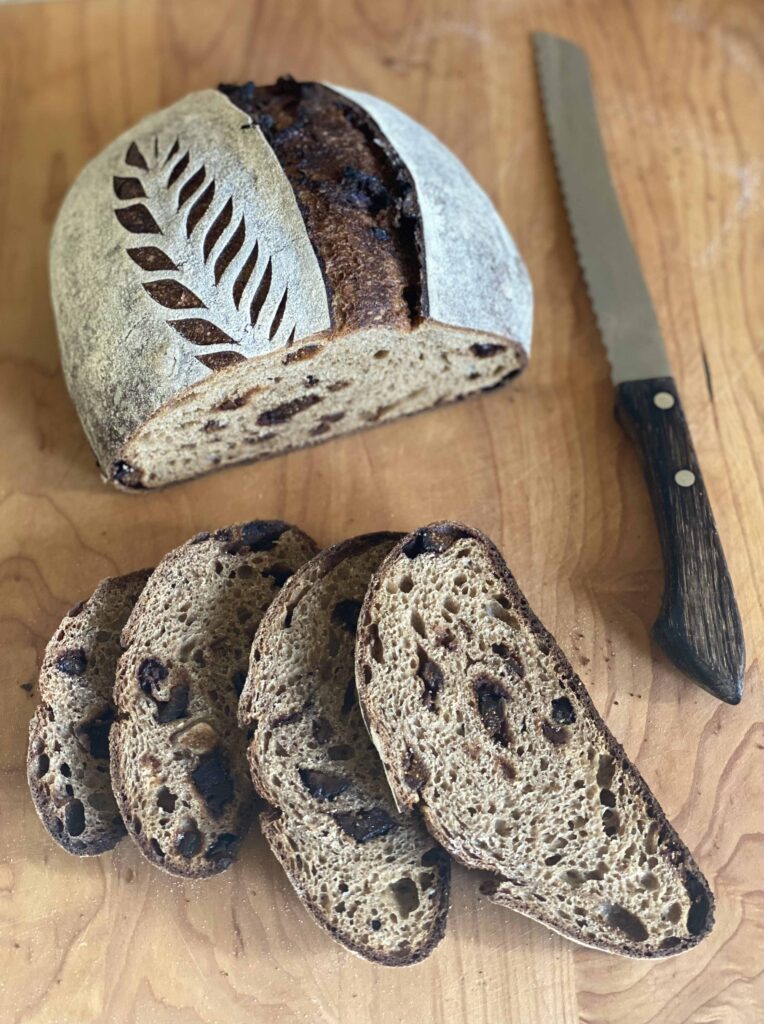
Flours for Sourdough Whole Grain Bread
A little of both rye and buckwheat flours go a long way and when combined with a robust whole wheat and a backbone of high-extraction bread flour, the results are a lofty hearth loaf with a pleasantly perfumed crumb.
This formula was developed using Central Milling’s Old World Bread Flour and tested with a variety of different stone-ground flours to provide the range of hydration noted below. The overall hydration should be adjusted to the flours of your choice, using the instructions below as a guide. When fermentation is delayed using the bassinage method, water can be added in stages, allowing the dough to come together with greater strength and improved fermentation. The warm, sweet character of Wren’s Abruzzi Rye or Gazelle Rye is enhanced when used to prepare the leaven and is a natural pairing with the figs, but any stone-ground whole rye flour will work. If you already work with sourdough rye bread recipes, you may have a rye sourdough starter, but if you don’t have a rye sourdough starter, create a rye leaven using 10% to 15% of your refreshed starter the night before mixing the dough.
Figs for Flavor + Fermentation
Using just a touch of Blue Ribbon Mission Fig Concentrate balances the earthiness of the flours without an overpowering sweetness and assists with impressive caramelization. Although the bold crust competes with the juicy diced Mission Figs as the star of this loaf, the loaf size below is enough to scale into a 9 x 5 x 2 ¾ -inch loaf pan.
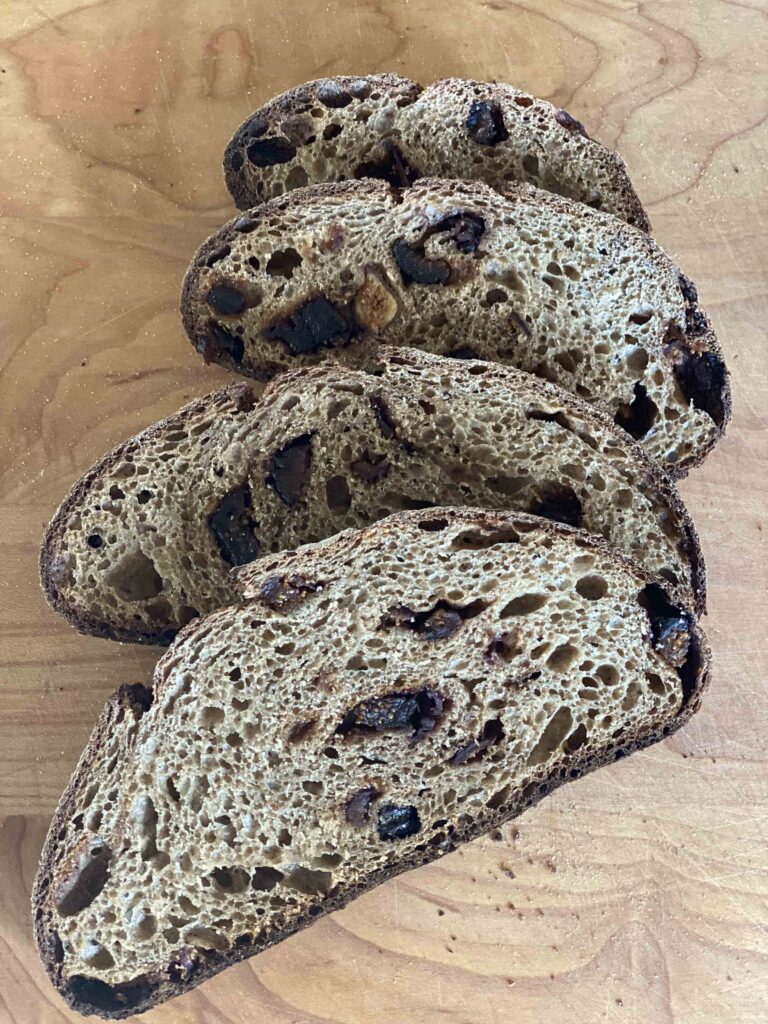
Figs in Fermentation
Blue Ribbon is a bread baker’s secret to bringing fruity fig flavor to breads with ease in ready-to-use fig ingredients. Fig concentrate adds color and flavor, but also the natural sugars can benefit your fermentation process. Learn more in Sarah Owens’ Figs and Sugar Fermentation Guide here.
How to Use Fig Ingredients in Bread-Baking
Use our soft fig puree to swirl into breads or to spread onto dough for babka. Our fig slurry provides a thinner consistency and can be lovely in challah. Or, try our diced figs in challah buns, and the rye buckwheat sourdough below.
Serving Ideas
Pair this sourdough whole grain bread with creamy brie or chèvre and a glass of red wine. Or, deeply toast a slice before smearing with salted cultured butter and your favorite chocolate hazelnut spread. Add this bread to your collection of sourdough rye bread recipes. Let’s bake!
Sourdough Whole Grain Bread with Figs

Ingredients
(Baker's Percentages noted below as BP)
- 657 to 765 grams water (73% to 85% BP)
- 70 grams Blue Ribbon Fig Concentrate (8% BP)
- 540 grams high-extraction bread flour (60% BP)
- 180 grams hard red whole wheat bread flour (20% BP)
- 120 grams whole rye flour (13% BP)
- 60 grams whole buckwheat flour (7% BP)
- 154 grams 100% hydration refreshed whole rye starter or leaven (17% BP)
- 18 grams fine sea salt (2% BP)
- 225 grams 3/8-inch Blue Ribbon Diced Mission Figs (25% BP)
Instructions
Mix and Autolyze (Rest) the Dough
- When the starter or leaven is almost ready, add 657 g of water into a large bowl along with the Fig Concentrate. Stir to combine. Add the flours to the bowl and using your hands, mix and squeeze the dough in a circular motion until no lumps remain, scraping down the sides as necessary. If using a mixer, mix the dough to incorporation. The dough should be shaggy and somewhat loose. Cover and rest the dough for about 45 to 60 minutes, allowing the bran to hydrate and the dough to strengthen.
Perform a Bassinage, if Necessary, and Add the Leaven and Salt
- After the dough has rested, test to see how it reacts to a stretch-and-fold: wet your hands first to prevent the dough from sticking and gently slide your fingers under the dough mass. Release the dough from the sides of the bowl and gently bring it to the center. Rotate the bowl and repeat 3 to 4 more times until you have worked your way around the dough mass. If the dough feels stiff or wants to tear, add additional water in increments of 20 g at a time or around 2% if using a mixer. If the dough is pooling instead, or if you are still honing your shaping skills, do not add additional water. Keep in mind the dough should be somewhat loose at the beginning, but as bulk fermentation continues and you perform more folds, the dough will increase in extensibility and should become more balanced with elasticity, or the ability for the dough to hold its shape.
- Add the leaven and salt to the bowl at the same time you add more water, if using. This is the fun and messy-squishy part! If using your hands, mix and squeeze the dough vigorously to incorporate the additional ingredients. It will appear as if the dough has regressed to its original ‘shaggy mass’ stage but it will soon recover. If using a mixer, mix until the dough shows signs of strength, continuing until the surface of the dough no longer appears slick, the leaven is completely incorporated, and the salt has evenly and fully dissolved into the dough. Cover the dough or if using a mixer, transfer to a container with a lid. Rest the dough for 15 to 20 minutes.
Fold in the Figs
- Evenly sprinkle one-third of the fig pieces over the surface of the dough. Wet your hands first to prevent the dough from sticking and gently slide your fingers under the dough mass. Release the dough from the sides of the bowl and gently fold it to the center. Rotate the bowl and repeat three to four more times until you have worked your way around the dough. Repeat this process of incorporating figs twice more, allowing the dough to rest for 15 to 20 minutes in between folds.
Pre-shape the Dough
- Shaping is done in two stages at the end of bulk fermentation: pre-shape with a short bench resting period followed by a tighter final shaping. Using a bowl scraper, swiftly remove the dough from the bowl and transfer to a lightly floured surface. Using a bench knife, divide the dough into two pieces. Gently pat one piece into a rectangle. Roll from the top down, loosely tucking as you go. Repeat with the second piece. Cover both with a dry towel or stiff, reusable plastic bag and bench rest for 10 to 15 minutes, or until the dough visibly relaxes.
Final-shape and Retard the Loaves Overnight
- Using a bench scraper, swiftly release the first piece and turn it over onto a lightly floured surface, seam side up. Repeat step #4, being mindful of gaining more tension with each movement. If the dough feels slack, it may benefit from stitching the dough together toward the middle to create more tension. Seal the final seam with a tuck of the bench scraper while simultaneously releasing the loaf from the work surface. Snuggle the loaf, seam side up, into a 9-inch proofing basket. Repeat with the second loaf. Cover the baskets with a dry cloth and a reusable plastic bag and place in the refrigerator for 12 to 16 hours. Because of the wholegrain flours, this dough will not hold for long periods in the refrigerator before being baked.
Final Proof the Loaves
- When ready to bake, remove the loaves from the refrigerator. Proof until puffy, inflated, and slightly domed. The loaves should just crest the top of the baskets. This will take anywhere from 0 to 3 hours, depending upon the temperature of your refrigerator and the location where you are proofing. Always watch the dough rather than the clock! When ready to bake the first loaf, place the second one back into the refrigerator to prevent it from over-proofing.
Preheat the Oven
- Place a Dutch oven with its lid on the middle rack. Preheat to 480°F for 30 to 45 minutes.
Bake the Loaves
- Turn the first loaf out onto a piece of parchment paper, seam side down, and score the length of the loaf ¼ -inch deep with a razor blade, or as desired. Carefully transfer it to the interior of the hot Dutch oven using the parchment paper as a sling. Position the lid and bake with steam for 20 minutes. Remove the lid and lower the oven temperature to 460°F. Continue baking on the middle rack for 20 to 25 more minutes, or until the crust is a deep dark brown. This loaf prefers a long, slow bake for the custardy crumb to set properly. If baked too hot, the crust will darken considerably before the loaf is done. Adjust the temperature of your oven accordingly.
Cool and Slice
- Remove the loaf from the oven and cool completely on a wire rack before slicing, about 3 hours. Repeat with the second loaf. Store the bread at room temperature wrapped in a beeswax-lined linen for up to 7 days.

